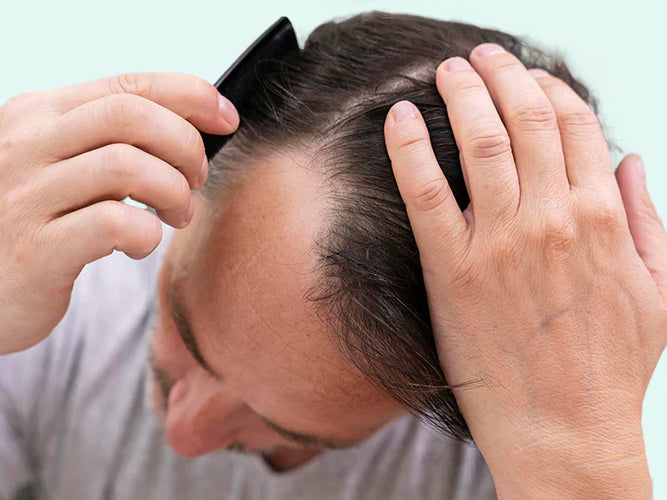Have you noticed your hair becoming thinner or your hairline gradually receding? You are certainly not alone. Hair loss in men often develops gradually and can start at a young age. Losing some hair every day is perfectly normal, but when does it become actual hair loss? What can you do to stop it from progressing?
This article explains why hair loss is so common in men, how to recognise the early signs and how to help slow down the process.
When is it considered hair loss?
Everyone naturally loses between 50 and 100 hairs a day as part of the normal growth cycle. Hair loss is only considered a problem when more hair falls out than grows back over time. At that stage, the hair gradually becomes thinner and bald patches may appear. It often only becomes noticeable once around 50 to 70 per cent of the hair in a specific area has disappeared.
How to recognise the early signs of hair loss in men
The first signs of hereditary hair loss usually appear at the temples or the crown, where the hair begins to thin first. Other indications include hair that becomes harder to style or more hair left behind in your brush. The Norwood Scale can help you estimate which stage of hair loss you are in.
Common early signs of hair loss:
- A receding hairline or deeper temples
- Thinning at the crown
- Hair that feels weaker or less dense
The sooner these signs are recognised, the easier it becomes to slow down further hair loss.
Why hair loss is so common in men
Hair loss in men rarely happens suddenly. It is usually caused by a combination of factors. The main cause is genetic predisposition, although hormones, stress and lifestyle also play a role.
Temporary hair loss caused by stress, illness or nutrient deficiencies
Not every type of hair loss is permanent. Stress, illness or a lack of essential nutrients can lead to temporary hair shedding, also known as telogen effluvium.
In this condition, many hairs enter the resting phase at the same time, causing them to fall out more quickly. The hair usually recovers once the body is back in balance.
Possible causes include:
- Severe stress or emotional strain
- Infection or high fever
- Deficiency of iron, zinc or vitamin D
- Certain medications or hormonal fluctuations
Hereditary predisposition (androgenetic alopecia)
The most common cause of permanent hair loss in men is androgenetic alopecia, also known as hereditary baldness. This form of hair loss results from a genetic sensitivity to DHT (dihydrotestosterone), a by-product of the male hormone testosterone.
In men with this predisposition, the hair follicles are more sensitive to DHT. Over time, this sensitivity causes the follicles to shrink, produce finer hair and eventually stop producing new hairs altogether. It is often assumed that men with higher testosterone levels go bald more quickly, which is not the case. It is not the amount of testosterone that matters, but how sensitive the hair follicles are to DHT.
Alopecia areata (patchy hair loss)
Another form of hair loss that can occur in men is alopecia areata. This is not hereditary baldness but an autoimmune reaction in which the body’s immune system temporarily attacks the hair follicles.
Hair loss usually appears suddenly and results in one or more round or oval bald patches on the scalp. In some cases, hair may also fall out in other areas, such as the beard, eyebrows or arms.
How to recognise alopecia areata:
• Smooth, round patches of hair loss on the scalp or in the beard
• Patches that appear suddenly, within a few days or weeks
Although this type of hair loss is usually temporary, it can return. There is currently no proven treatment for alopecia areata.
Lifestyle and external influences
Lifestyle has a strong influence on the condition of the hair. Smoking, for instance, reduces blood flow to the scalp, meaning that the hair follicles receive fewer nutrients. An unbalanced diet, lack of sleep or prolonged stress can also accelerate hair loss.
External factors such as heat, pollution and harsh hair products can further weaken the scalp. A healthy lifestyle with sufficient sleep, exercise and nutrition not only supports your overall health, but also the growth of strong hair.
What can you do about hair loss?
Although genetic predisposition cannot be changed, it is possible to influence the rate of hair loss. The key is to start early and choose an approach that suits your situation.
Support hair growth from within
A healthy diet is the foundation for strong hair. A lack of essential nutrients can worsen hair loss or slow down growth.
Important nutrients for healthy hair include:
- Biotin
- Vitamin D
- Iron and zinc
Eat a varied diet with plenty of vegetables, fruit, wholegrains and protein. Stay hydrated and limit processed foods, sugar and alcohol.
Keep your scalp in good condition
A healthy scalp is essential for maintaining healthy hair. Use gentle, sulphate-free shampoos and avoid harsh products that may irritate the skin. Scalp massages can help to stimulate local blood flow. Avoid using styling tools that are too hot or tight hairstyles that pull on the hair.
Use natural ingredients wisely
There is no miracle cure that completely stops hereditary baldness. However, certain natural ingredients can help to slow the process. Examples include natural DHT-modulating ingredients such as:
- Biotin
- Saw palmetto
- Green tea
Visit our Ingredients page to discover which substances are known to support healthy hair and scalp condition.
Be cautious with products that may cause side effects
Some hair-loss treatments contain potent substances that can affect hair growth but may also lead to side effects.
For example, finasteride is sometimes prescribed to inhibit DHT production, although it may cause effects such as reduced libido, mood changes or hormonal imbalance.
Shampoos containing ketoconazole, an antifungal ingredient, are also occasionally used to maintain a healthy scalp, but long-term or excessive use can lead to irritation or dryness.
It is always best to consult a general practitioner or dermatologist before using such products. There are also milder, more natural alternatives that can help care for the scalp and hair without affecting hormone balance.
When to seek professional advice
It is advisable to consult a doctor or dermatologist if:
- Hair loss occurs suddenly
- Bald patches or inflammation appear on the scalp
- The scalp feels painful, itchy or irritated
A professional can determine whether it is hereditary baldness or another underlying condition.
Conclusion
Hair loss in men is common and can have several causes. Sometimes it is temporary – for example, due to stress, illness or a nutritional deficiency – and hair usually regrows once balance is restored.
In cases of androgenetic alopecia, the process can often be slowed down through early, consistent care and suitable support.
Other conditions, such as alopecia areata, currently have no proven treatment. This type of hair loss may resolve on its own, although not everyone experiences full regrowth.
The most important step is understanding which type of hair loss you have and what is realistically possible. By seeking advice in good time and taking proper care of your scalp and general health, you can help maintain the best possible condition of your hair.
Sources
Horsley, V., & Ritchie, J. (2022). Androgenetic alopecia: Therapy update. Drugs, 83(12), 1899–1913. https://link.springer.com/article/10.1007/s40265-023-01880-x
Juhász, M., & Juhász, A. (2018). Frontiers in Nutrition, 11, 1433962. Tea and nutrition in hair-loss: Influence of dietary and lifestyle factors in androgenetic alopecia and telogen effluvium.
Ranganathan, S., & Kavi, A. G. (2015). Telogen effluvium: A review of the literature. Indian Journal of Dermatology, Venereology and Leprology, 81(5), 477–486.
Cleveland Clinic. (n.d.). Telogen effluvium: Symptoms, causes, treatment & regrowth. Cleveland Clinic.
Mayo Clinic. (n.d.). What is alopecia areata? Mayo Clinic Press. https://mcpress.mayoclinic.org/living-well/what-is-alopecia-areata/
This information does not replace professional medical advice. If in doubt, always consult a doctor or specialist.













